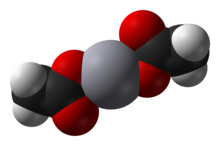
| |

| |
| Names | |
|---|---|
| Other names
mercuric acetate
mercuriacetate | |
| Identifiers | |
3D model (JSmol)
|
|
| ChEBI | |
| ChemSpider | |
| ECHA InfoCard | 100.014.993 |
| EC Number |
|
PubChem CID
|
|
| RTECS number |
|
| UNII | |
| UN number | 1629 |
CompTox Dashboard (EPA)
|
|
| |
| |
| Properties | |
| C4H6O4Hg | |
| Molar mass | 318.678 g/mol |
| Appearance | white solid |
| Odor | mild vinegar odor |
| Density | 3.28 g/cm3, solid |
| Melting point | 179 °C (354 °F; 452 K) (decomposes) |
| 25 g/100 mL (10 °C) 100 g/100 mL (100 °C) | |
| Solubility | soluble in alcohol, diethyl ether |
| −100·10−6 cm3/mol | |
| Hazards | |
| GHS labelling: | |
  
| |
| Danger | |
| H300, H310, H330, H373, H410 | |
| P260, P262, P264, P270, P271, P273, P280, P284, P301+P310, P302+P350, P304+P340, P310, P314, P320, P321, P322, P330, P361, P363, P391, P403+P233, P405, P501 | |
| NFPA 704 (fire diamond) | |
| Lethal dose or concentration (LD, LC): | |
LD50 (median dose)
|
40.9 mg/kg (rat, oral) 23.9 mg/kg (mouse, oral)[1] |
Except where otherwise noted, data are given for materials in their standard state (at 25 °C [77 °F], 100 kPa).
| |
Mercury(II) acetate, also known as mercuric acetate is a chemical compound, the mercury(II) salt of acetic acid, with the formula Hg(O2CCH3)2. Commonly abbreviated Hg(OAc)2, this compound is employed as a reagent to generate organomercury compounds from unsaturated organic precursors. It is a white, water-soluble solid, but some samples can appear yellowish with time owing to decomposition.
- ^ "Mercury (organo) alkyl compounds (as Hg)". Immediately Dangerous to Life or Health Concentrations (IDLH). National Institute for Occupational Safety and Health (NIOSH).
